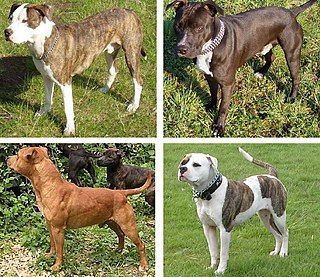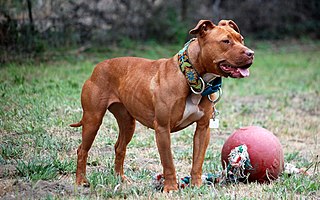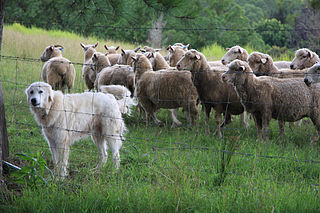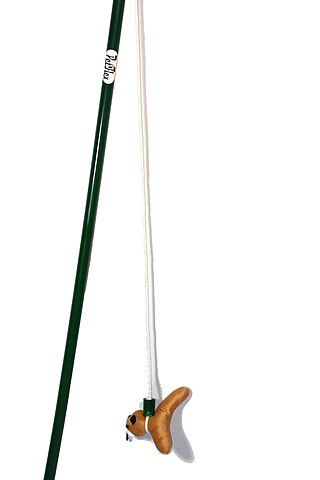
Prey drive is the instinctive inclination of a carnivore to find, pursue, and capture prey; this instinct can be refined for industrial purposes such as herding livestock.

Prey drive is the instinctive inclination of a carnivore to find, pursue, and capture prey; this instinct can be refined for industrial purposes such as herding livestock.
The predatory motor sequence follows a sequence: search (orient, nose/ear/eye); stalk; chase; bite (grab-bite, kill-bite); dissect; and consume. [1]
In different breeds of dogs, certain steps of these have been amplified or reduced by human-controlled selective breeding for various purposes. The "search" aspect of the prey drive is used in detection dogs such as bloodhounds and beagles. The "eye-stalk" is for herding dogs. The "chase" is seen in sighthounds such as Greyhounds and lurchers, while the "grab-bite" and "kill-bite" are for the training of terriers. In most dogs, prey drive can occur without extrinsic reinforcement.
In dog training, prey drive can be used as a performative advantage because dogs with strong prey drive are more willing to pursue moving objects such as toys, which can then be used to encourage certain kinds of behavior, such as that of greyhound racing or the speed required in dog agility. [2] Prey drive can affect training in Schutzhunds as well. [3]
Retrievers are sometimes expected to chase prey and bring it back to the human hunter, but not bite or damage it. Bull Terriers, such as the Staffordshire Bull Terrier, have an amplified grab-bite as they were originally bred to bait bulls (restrain bulls by hanging onto their noses), but never needed to find or stalk the prey.

The Whippet is a British breed of medium-sized dog of the sighthound type, related to the larger Greyhound and the smaller Italian Greyhound. Aside from size differences, the Whippet closely resembles these two breeds and is sometimes referred to as the "miniature Greyhound" or, colloquially, as "the poor man's racehorse." The breed is commonly kept as a companion dog, for competitive showing, and for amateur racing. Additionally, Whippets participate in various dog sports, including lure coursing, agility, and flyball. Known for its remarkable speed, the Whippet holds the title for the fastest running speed within its weight and size range, and is believed to have the fastest idle-to-running acceleration of any dog.

Pit bull is an umbrella term for several types of dog believed to have descended from bull and terriers. In the United States, the term is usually considered to include the American Pit Bull Terrier, American Staffordshire Terrier, American Bully, Staffordshire Bull Terrier, and sometimes the American Bulldog, along with any crossbred dog that shares certain physical characteristics with these breeds. In other countries, including the United Kingdom, the term is used as an abbreviation of the American Pit Bull Terrier breed specifically, while the Staffordshire Bull Terrier is not considered a pit bull. Most pit bull–type dogs descend from the British bull and terrier, a 19th-century dog-fighting type developed from crosses between the Old English Bulldog and the Old English Terrier.

A herding dog, also known as a stock dog or working dog, is a type of dog that either has been trained in herding livestock or belongs to one of the breeds that were developed for herding. A dog specifically trained to herd sheep is known as a sheep dog or shepherd dog, and one trained to herd cattle is known as a cattle dog or cow dog.

In law, breed-specific legislation (BSL) is a type of law that prohibits or restricts particular breeds or types of dog. Such laws range from outright bans on the possession of these dogs, to restrictions and conditions on ownership, and often establishes a legal presumption that such dogs are dangerous or vicious to prevent dog attacks. Some jurisdictions have enacted breed-specific legislation in response to a number of fatalities or maulings involving pit bull–type dogs or other dog breeds commonly used in dog fighting, and some government organizations such as the United States Army and Marine Corps have taken administrative action as well. Due to opposition to such laws in the United States, anti-BSL laws have been passed in 21 of the 50 state-level governments, prohibiting or restricting the ability of jurisdictions within those states to enact or enforce breed-specific legislation.
Canine terminology in this article refers only to dog terminology, specialized terms describing the characteristics of various external parts of the domestic dog, as well as terms for structure, movement, and temperament. This terminology is not typically used for any of the wild species or subspecies of wild wolves, foxes, coyotes, dholes, jackals or the basal caninae. Dog terminology is often specific to each breed or type of dog. Breed standards use this terminology in the description of the ideal external appearance of each breed, although similar characteristics may be described with different terms in different breeds.

The American Pit Bull Terrier (APBT) is a dog breed recognized by the United Kennel Club (UKC) and the American Dog Breeders Association (ADBA), but not the American Kennel Club (AKC). It is a medium-sized, short-haired dog, of a solid build, whose early ancestors came from England. When compared with the English Staffordshire Bull Terrier, the American Pit Bull Terrier is larger by margins of 6–8 inches (15–20 cm) in height and 25–35 pounds (11–16 kg) in weight. The American Pit Bull Terrier varies in size: males are normally about 18–21 inches (45–53 cm) in height and around 35–60 pounds (15–27 kg) in weight, while females are normally around 17–20 inches (43–50 cm) in height and 30–50 pounds (13–22 kg) in weight.

The McNab Dog, also called the McNab Shepherd or McNab Collie is a herding dog that originated in Hopland, Mendocino County, Northern California. The McNab was bred to withstand the tough conditions found in California such as heat, burrs, foxtails, and rugged terrain. Until recently, the McNab was little known outside California, but in last three decades have seen a gain in popularity and geographic dispersal of the breed.

Dog aggression expressed by dogs is considered to be normal behaviour and various types of aggression are influenced by a dog's environment and genetic predisposition. Dogs commonly display possessive aggression when defending resources or themselves.

The Teddy Roosevelt Terrier is a small to medium-sized American hunting terrier. It is lower-set, with shorter legs, and is more muscular with heavier bone density than the related American Rat Terrier. Much diversity exists in the history of the Teddy Roosevelt Terrier breed, and it shares a common early history with the American Rat Terrier, Fox Paulistinha, and Tenterfield Terrier. The Rat Terrier's background is said to stem from the terriers or other dogs that were brought over by early English and other working-class immigrants. Since the breed was a farm, hunting, and utility dog, little to no planned breeding was used other than breeding dogs with agreeable traits to each other to produce the desired work ethic in the dog. The Feist (dog), Bull Terrier, Smooth Fox Terrier, Manchester Terrier, Whippet, Italian Greyhound, the now extinct English White Terrier, Turnspit Dog, and Wry-legged Terrier all share in the Teddy Roosevelt Terrier's ancestry. These early ratting terriers were then most likely bred to the Beagle or Beagle crossbred dogs and other dogs. Maximizing the influences from these various breeds provides the modern Teddy Roosevelt Terrier with a keen sense of awareness and prey drive, an acute sense of smell, and a very high intellect. Although they tend to be aloof with strangers, they are devoted companion dogs with a strong desire to please and be near their owners at all times.

The Bull Terrier is a breed of dog in the terrier family. There is also a miniature version of this breed which is officially known as the Miniature Bull Terrier. This breed originates in 19th century England. Bull Terriers are most recognised by their unique head features. The Bull Terrier was originally bred for vermin control and bloodsports.

Bull and terrier was a common name for crossbreeds between bulldogs and terriers in the early 1800s. Other names included half-and-halfs and half-breds. It was a time in history when, for thousands of years, dogs were classified by use or function, unlike the modern pets of today that were bred to be conformation show dogs and family pets. Bull and terrier crosses were originally bred to function as fighting dogs for bull- and bear-baiting, and other popular blood sports during the Victorian era. The sport of bull baiting required a dog with attributes such as tenacity and courage, a wide frame with heavy bone, and a muscular, protruding jaw. By crossing bulldogs with various terriers from Ireland and Great Britain, breeders introduced "gameness and agility" into the hybrid mix.

A feist is a small hunting dog. This group descended from the terriers brought over to the United States by British miners and other immigrants. These terriers probably included crosses between the Smooth Fox Terrier, the Manchester Terrier, and the now-extinct English White Terrier. These dogs were used as ratters, and gambling on their prowess in killing rats was a favorite hobby of their owners. Some of these dogs have been crossed with Greyhounds, Whippets or Italian Greyhounds, and Beagles or other hounds – extending the family to include a larger variety of purpose than the original ratter, or Rat Terrier.

Dog behavior is the internally coordinated responses of individuals or groups of domestic dogs to internal and external stimuli. It has been shaped by millennia of contact with humans and their lifestyles. As a result of this physical and social evolution, dogs have acquired the ability to understand and communicate with humans. Behavioral scientists have uncovered a wide range of social-cognitive abilities in domestic dogs.

A working terrier is a type of terrier dog bred and trained to hunt vermin including a badger, fox, rat and other small mammals. This may require the working terrier pursuing the vermin into an underground warren. These working dog breeds are neither bred primarily for a dog show nor as a companion dog, rather they are valued for their ability to hunt, endurance and gameness. Working terriers provide utility on farms, for pest control and organized hunting activities. A terrierman leads a pack of terriers when they are working.

A livestock guardian dog (LGD) is a dog type bred for the purpose of protecting livestock from predators.

Dog types are broad categories of domestic dogs based on form, function, or style of work, lineage, or appearance. Some may be locally adapted dog types that may have the visual characteristics of a modern purebred dog. In contrast, modern dog breeds strictly adhere to long-established breed standards,[note 1] that began with documented foundation breeding stock sharing a common set of inheritable characteristics, developed by long-established, reputable kennel clubs that recognize the dog as a purebred.

The American Bully is a modern breed of dog that was developed as a companion dog, and originally standardized and recognized as a breed in 2004 by the American Bully Kennel Club (ABKC). Their published breed standard describes the dog as giving the "impression of great strength for its size". In 2008, the American Bully was recognized by the European Bully Kennel Club (EBKC), and on July 15, 2013, by the United Kennel Club (UKC). The UK Kennel Club, American Kennel Club, and International Canine Federation do not recognize the American Bully as a separate breed.

A flirt pole, also called a "flirt stick", is a piece of exercise equipment for dogs that entices a dog to chase a fast moving lure. This equipment is often used to physically condition a dog and improve the dog's skills for better performance in certain competitions such as lure-coursing or Schutzhund. It is often used simply to get a dog to exert a lot of energy in a small space.
The body language of dogs is one form of non-verbal communication whereby dogs can express emotions and intentions through bodily movements. It refers to the interpretation of posture and behaviour of species in the genus Canis. This form of visual communication is generally used for identifying emotions and intentions of domestic dogs, though it can also be applied to wild canines such as wolves. Understanding the body language of dogs is particularly important in preventing dog bites, especially of children. This communication can occur between dogs, or during a dog-human interaction. Such movements primarily involve the tail, the ears, and the head/body. Tail-wagging is a common tail movement used by dogs to communicate. Additionally, ear flattening or heightening are typical movements made using the ears. In terms of the head/body, it is of interest to study turning of the head, as well as the overall posture of the dog.
Fatal dog attacks are human victim's deaths caused by dogs. The study of fatal dog attacks can lead to prevention techniques which can help to reduce all dog bite injuries, not only fatalities. Dog bites and attacks can result in pain, bruising, wounds, bleeding, soft tissue injury, broken bones, loss of limbs, scalping, disfigurement, life-threatening injuries, and death.